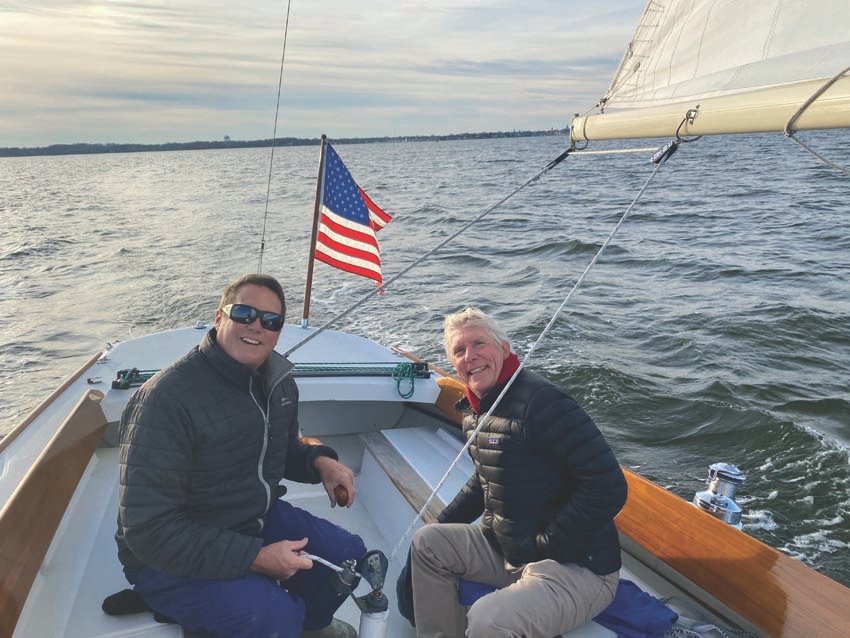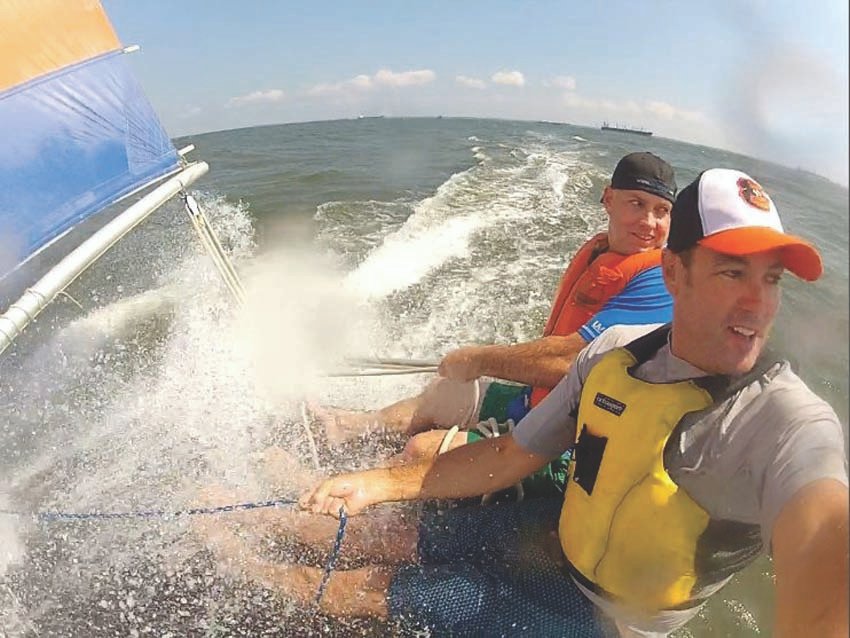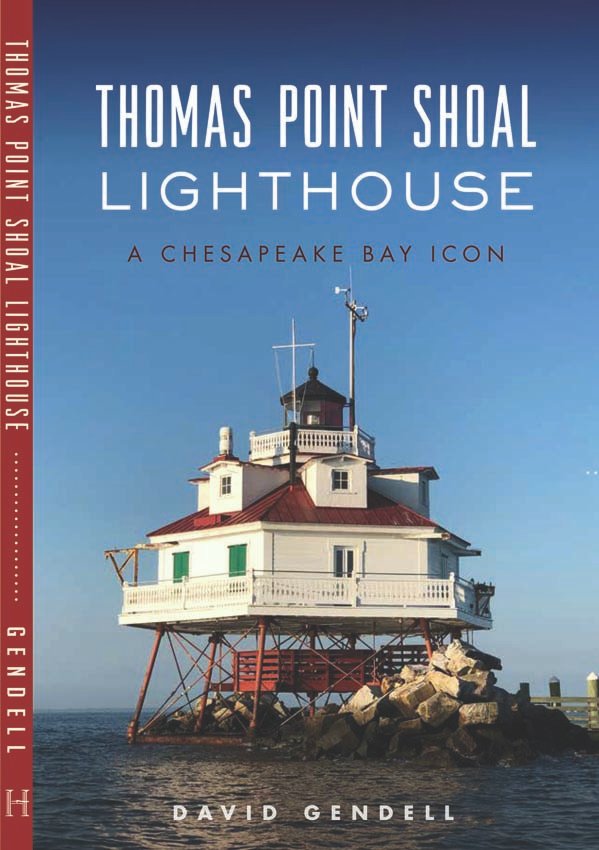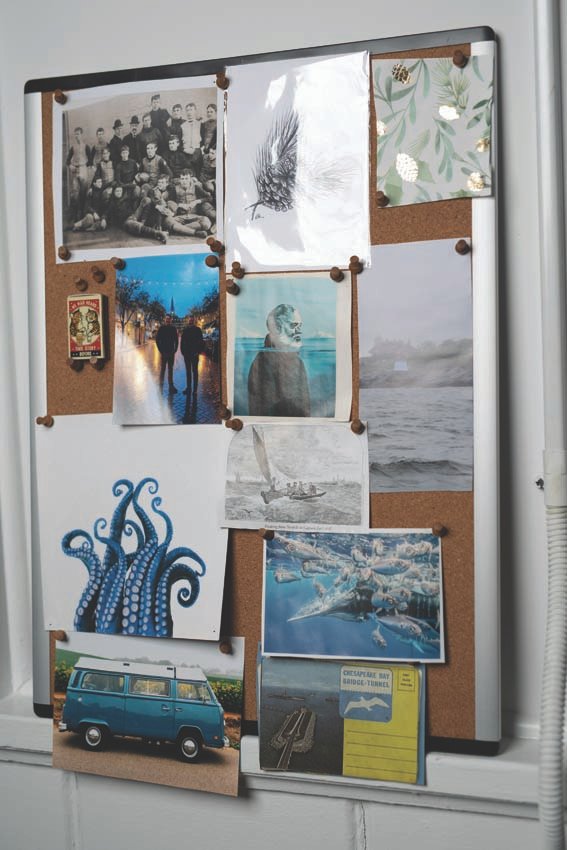+ By Dylan Roche + Photos by Gregg Patrick Boersma
Is David Gendell as a sailor who writes or as a writer who sails? Both identities are tightly woven in the author of Thomas Point Shoal Lighthouse: A Chesapeake Bay Icon. His 2020 debut traces the many stories surrounding the National Historic Landmark located at 38.907 degrees North and 76.4660 degrees West. If you ask Gendell himself, the answer is easy. “At the core of who I am, I consider myself a sailor,” he says. “It’s the activity from which everything else stems.”
Through sailing, Gendell discovered his talents as a wordsmith, back when he was a college student. He wrote letters to his grandmother, a retired English teacher, telling her about his sailing adventures as far as Bermuda, the Caribbean, and Nova Scotia. “I started writing her letters reporting what we were doing,” he recalls. “That really showed me that if I took some time and looked at it, I could write about what I was doing and feeling and experiencing to an audience.”
Gendell’s audience has grown over the years as he’s launched magazines and labored over manuscripts. With the release of his book, he’s navigating exciting new waters as an author. But it all goes back to his love of his subject matter: being out on the boat.
The oldest of three boys growing up on the Magothy River in the 1980s, Gendell spent his childhood and adolescence learning to swim and sail, catching crabs off of his family’s dock, mucking around muddy banks, and venturing out on the ice during the coldest parts of winter. By age 14, he saved up his money to buy a Laser, which he sailed on ambitious solo trips to Annapolis a few times. At age 16, he was teaching at the Annapolis Sailing School, a job he cites as formative because of the connections he made and the confidence he gained. By age 19, he had his captain’s license.
It all led him to those sailing trips worth writing home about and, ultimately, a realization that he loved storytelling. Once out of college, he got a job writing for Rags Magazine, a startup that lasted about a year and half. After it folded, he and friend Mary Iliff Ewenson saw a need in the Annapolis area for a sailing magazine. Because Gendell had the creative mind with a vision for stories and photos and Ewenson had the business mind and strength in advertising sales, they successfully fulfilled that vision with the launch of SpinSheet Magazine in 1995.
“We have super different strengths and we had a really great divide-and-conquer approach to running the business,” says Ewenson. “He knew the sailing community really well. He has a really good way of capturing not just the right words but the feel of what he’s talking about so that when he tells a story, it’s not just grammatically correct and factually correct, but you get the whole picture.”
While Ewenson continues to run SpinSheet as publisher, Gendell left to pursue a career in technology. Even with his new day job, he never gave up writing. “Some guys play golf, some guys play guitar, some guys restore old cars in their garage. I like nothing more than to dial into a local topic—the Chesapeake Bay, Annapolis, maybe a historical topic—and learn as much as I can, and piece it all together with some personality, and then write about it.” He guesses that he’s researched and written about 25 different topics over the years. He’s also assembled a manuscript about the Annapolis waterfront during World War II, a project that has taken 20 years and accumulated at least 250,000 words—he’s trimmed the length down to a more reasonable 100,000.

But in 2019, he set that project aside and focused on Thomas Point Shoal Lighthouse. He describes the landmark as “such an iconic spot and such an interesting spot,” and knew that tracing the events and stories surrounding it would give him plenty of material. “I sat down and made a list of what happened at the lighthouse—storms and different keepers and different events,” he says. “I started expanding out the timeline and realized there’s a story. I thought, ‘I’m going to write this through, from beginning to end.’”
He started querying publishers of books about lighthouses, and within 24 hours, he had a contract offer from Arcadia Publishing. The research took him all over Maryland and into Washington, D.C., as he looked through the archives of the Baltimore Sun and the Capital Gazette, along with the Lighthouse Board’s official records at the National Archives.
Gendell’s mark as a researcher and storyteller is his passionate connection to his subject matter, according to Ewenson. “He’s a neat mix of loving history and going out and doing things,” she says. “If he’s writing about the lighthouse, he’s going out and taking photos, fishing off the structure around the lighthouse, being out there at sunrise and sunset, and thinking about what it was like for the keepers, years ago . . . [W]hen he’s covering something current, he grounds it with historical references. And when he writes about history, he brings in present day.”

Releasing a book during a pandemic presented a marketing challenge, as Gendell was limited when it came to in-person events. Even so, the response to the book has been enthusiastic. “I’m thrilled by the way it’s been received,” he says. “There’s a core of people who love that lighthouse—it’s a central part of their lives—and that group has been incredibly supportive.”
With a readership base already forming, Gendell is setting his sights on future research and writing projects. He remains grateful that people appreciate his passion for these endeavors. “I’m surrounded by people and family who get me and support me,” he says. “If I’m at the archives for six hours on end on a Saturday and come back with my head spinning and need to sit down and go through it all for a couple more hours, they understand and stay supportive.” █
David Gendell’s book can be ordered at arcadiapublishing.com or purchased at Alltackle Annapolis, Annapolis Maritime Museum, or Fawcett Boat Supplies.

















